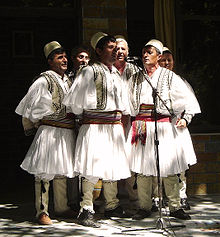| Iso-Polyphony | |
|---|---|
 A traditional male group performing | |
| Native name | Iso-polifonia |
| Stylistic origins | Albanian music |
| Typical instruments | Human voice |
| Albanian folk iso-polyphony | |
|---|---|
| Country | Albania |
| Reference | 00155 |
| Region | Europe and North America |
| Inscription history | |
| Inscription | 2008 (3rd session) |
| List | Representative |
Iso-Polyphony (Albanian: Iso-polifonia) is a traditional part of Albanian folk music and, as such, is included in UNESCO's intangible cultural heritage list.[1] Albanian Iso-Polyphony is considered to have its roots in the many-voiced vajtim, the southern Albanian traditional lamentation of the dead. The instrumental expression of the Albanian Iso-Polyphony evolved into the Albanian kaba.[2]
All four regions of southern Albania—Lalëria (Myzeqe), Toskëria, Çamëria, and Labëria—have polyphonic song as part of their culture. A related form of polyphonic singing is found in northern Albania, in the area of Peshkopi; Polog, Tetovo, Kičevo and Gostivar in North Macedonia; and Malësia in northern Albania and southern Montenegro.[3]
Labëria is particular well known for multipart singing; songs can have two, three, or four parts. Two-part songs are sung only by women. Three-part songs can be sung by men and women. Four part songs are a Labërian specialty. Research has shown that four-part songs developed after three-part ones, and that they are the most complex form of polyphonic singing.[4]
The Gjirokastër National Folklore Festival, Albania, (Albanian: Festivali Folklorik Kombëtar), has been held every five years in the month of October since 1968, and it typically includes many polyphonic songs.[5]
- ^ "UNESCO Culture Sector – Intangible Heritage – 2003 Convention". Unesco.org. Retrieved 2013-09-22.
- ^ Tole 2022, pp. 43–45.
- ^ Ardian Ahmedaja, Gerlinde Haid (2008). European voices: Multipart singing in the Balkans and the Mediterranean, Volume 1, p. 210, 243–44. ISBN 9783205780908.
- ^ Ahmedaja, Haid (2008), p.214-215
- ^ Ahmedaja, Haid (2008), p.241